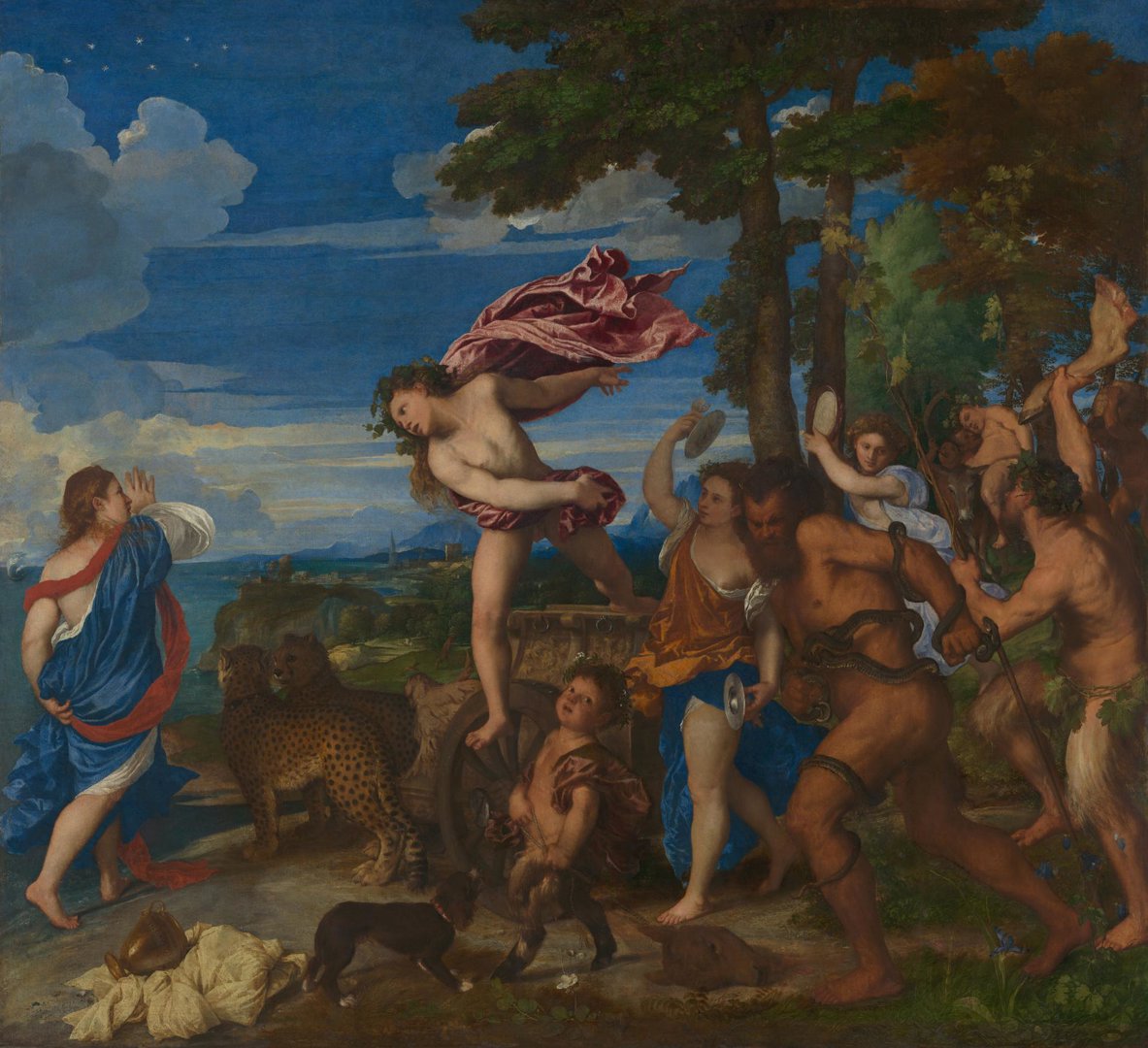Titian's 'Bacchus and Ariadne'
Audio description
This is a description of 'Bacchus and Ariadne' painted between 1520 and 1523 by the Venetian artist, Tiziano Vecellio – or Titian, as he is better known. A work of oil on canvas, this is a large painting almost 2 metres square. The painting's thick golden frame is decorated with lush, intertwined foliage, bunches of grapes, and the faces of winged children.
In a riot of colour, against a brilliant blue sky and rolling white clouds, a group of at least 10 diverse, partially clothed or naked figures, burst out of a forest on the right of the painting. They are cavorting towards a cliff on the left, overlooking the sea.
The procession is led by a youthful, naked man in the centre of the painting, riding a wooden chariot pulled by two spotted cheetahs. This is Bacchus, the god of wine, a crown of vine leaves tangled in his wild, brown curls. He is leaping from the chariot, one bare foot in the air, his pink cape fluttering out behind him. Bacchus has fallen, quite literally, head over heels in love with the woman standing on the edge of the cliff, on the left of the painting. As he jumps, he is staring at her, his mouth hanging open.
She is barefoot, facing the sea, her back to us. Enrobed in bright blue cloth and a red sash, her auburn hair tumbles over one shoulder. This is the Cretan princess Ariadne. Her head turns in profile towards Bacchus, as if she has just noticed him. Her right arm is reaching out, palm held up, not towards Bacchus, but to the sea. It is a gesture that suggests, “Stop.” Far in the distance, just above her shoulder near the left edge of the painting, a tiny ship is sailing away.
This image represents a Greek myth, quite likely based on a passage from Ovid’s Metamorphoses. The ship carries Ariadne’s lover, Theseus, who has abandoned her on this isle of Naxos.
Behind the cart, the followers of Bacchus are leaping and dancing. In the centre of the painting, at the bottom, a small dog barks up at a child-like figure who looks out at us. He walks on hooves, with short, furry goat legs. He is a satyr, or fawn, a woodland creature, and he drags a severed deer’s head by a rope. Behind him, to the right, strides a large, scowling man, naked except for snakes wrapped around his body. Behind him, another man waves the leg of the decapitated deer in one hand, the other brandishing a wooden staff entwined with vines. Music is played by two women further back in the composition, their loose dresses exposing breasts and thighs. They play cymbals and tambourine. Further back still, an opulent figure is slumped on a donkey, and another blows a horn.
The artist has signed his name on a golden pot, lying on a yellow cloth in the bottom left of the painting. In the top left, a circle of stars twinkles in the sky. According to the myth, Bacchus, professing his love to Ariadne, offers her this crown of stars. In one version of the tale, he immortalises her as the stars themselves, and she becomes the aurora borealis, or “northern crown”.
Titian painted this opulent scene for the Duke of Ferrara, to hang in his palace, alongside other mythological scenes. Displaying the wealth of the commission, Titian has painted vast expanses of ultramarine, made from crushed lapis lazuli gemstones, a pigment 100 times more expensive than any other. He has used it across the sky, the sea, Ariadne’s robe, and the clothes of some of Bacchus’s followers. He has even included small blue flowers in the bottom right corner.


